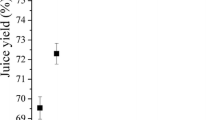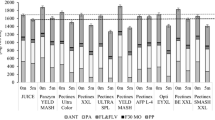Abstract
Bilberries (Vaccinium myrtillus L.) and black currants (Ribes nigrum L.), dark blue berries rich in anthocyanins, were processed with an aid of commercial pectinolytic enzyme preparations, and the effect of processing on berry anthocyanins was investigated. The enzyme preparations were dosed based on their polygalacturonase activity from 1 to 100 nkat/g of berry mash. The juice yields were determined by weighing, and anthocyanin analyses were performed with HPLC. The bilberry and black currant juice yields increased significantly in enzyme-aided treatments with comparison to control, even with the lowest (1 nkat/g) polygalacturonase dosage. The anthocyanin yield increased by up to 83% for bilberries and up to 58% for black currants in enzyme-aided treatments as compared to control. The results showed that higher polygalacturonase dosage was needed for black currant to achieve the maximal juice and anthocyanin yields than for bilberries. The stability and the profile of extracted anthocyanins were greatly affected by the glycosidase side activities present in the enzyme preparations, which were able to hydrolyze certain anthocyanins to the corresponding aglycones. In addition, the data indicate that anthocyanidin rutinosides were more easily extracted than those of glucosides, which prevailed over the arabinosides and galactosides. Thus, prior to processing it is important to know the intact anthocyanin structures of the raw material, and the activity profile of the enzyme preparation to obtain optimal anthocyanin extractability and enzyme dosage.






Similar content being viewed by others
Abbreviations
- HCl:
-
Hydrochloric acid
- PG:
-
Polygalacturonase
- PL:
-
Pectin lyase
- TAC:
-
Total anthocyanin concentration
- TAY:
-
Total anthocyanin yield
References
Macheix JJ, Fleuriet A, Billot J (1990) Flavonoids. In: Macheix JJ, Fleuriet A, Billot J (eds) Fruit phenolics. CRC Press, Boca Raton, pp 39–80
Andersen OM, Jordheim M (2005) Anthocyanins. In: Andersen OM, Markham KR (eds) Flavonoids: chemistry, biochemistry and applications. CRC Press, Boca Raton
Clifford MN (2000) J Sci Food Agric 80:1063–1072
Kong JM, Chia LS, Goh NK, Chia TF, Brouillard R (2003) Phytochemistry 64:923–933
Hou DX (2003) Curr Mol Med 3:149–159
Prior RL (2003) Am J Clin Nutr 78(suppl):570S–578S
Koponen JM, Happonen AM, Mattila PH, Törrönen AR (2007) J Agric Food Chem 55:1612–1619
Goiffon JP, Brun M, Bourrier MJ (1991) J Chromatogr 537:101–121
Kähkönen M, Heinämäki J, Olliainen V, Heinonen M (2003) J Sci Food Agric 83:1403–1411
Määttä-Riihinen K, Kamal-Eldin A, Mattila P, González-Paramás A, Törrönen R (2004) J Agric Food Chem 52:4477–4485
Pilnik W, Voragen AG (1991) The significance of endogenous and exogenous pectic enzymes in fruit and vegetable processing. In: Fox PF (ed) Food enzymology, vol 1. Elsevier, London, pp 303–336
Voragen AG, Pilnik W, Thibault JF, Axelos MA, Renard CM (1995) Pectins. In: Stehen AM (ed) Food polysaccharides and their applications. Marcel Dekker, New York, pp 287–339
Buchert J, Koponen JM, Suutarinen M, Mustranta A, Lille M, Törrönen AR, Poutanen K (2005) J Sci Food Agric 85:2548–2556
Landbo AK, Meyer A (2004) Inn Food Sci Emerg Technol 5:303–313
Bagger-Jørgensen R, Meyer A (2004) Eur Food Res Technol 219:620–629
Hilz H, Bakx E, Schols H, Voragen A (2005) Carbohydrate Polym 59:477–488
Wightman JD, Wrolstad RE (1995) J Food Sci 60:862–867
Mandalari G, Bennett RN, Kirby AR, Lo Curto RB, Bisignano G, Waldron KW, Faulds CB (2006) J Agric Food Chem 54:8307–8313
Kader F, Haluk JP, Nicolas JP, Metche M (1998) J Agric Food Chem 46:3060–3065
Skrede G, Wrolstad RE, Durst RW (2000) J Food Sci 65:357–364
Lee J, Wrolstad R (2004) J Food Sci 69:564–573
Landbo AK, Meyer A (2001) J Agric Food Chem 49:3169–3177
Bordignon-Luiz MT, Gauche C, Gris EF, Falcão LD (2007) LWT Food Sci Technol 40:594–599
Pacheco-Palencia LA, Palo Hawken P, Talcott ST (2007) Food Res Int 40:620–628
Hubbermann EM, Heins A, Stöckmann H, Schwarz K (2006) Eur Food Res Technol 223:83–90
Acknowledgments
This study has been carried out with financial support from the Commission of the European Communities, specific RTD programme “Quality of Life and Management of Living Resources”, contract number QLRT-CT-2002-02364 “Novel enzyme-aided extraction technologies for maximized yield and functionality of bioactive components in consumer products and ingredients from by-products”, acronym MAXFUN. It does not reflect its views and in no way anticipates the Commission’s future policy in this area. Riitta Alander is thanked for the technical assistance.
Author information
Authors and Affiliations
Corresponding author
Rights and permissions
About this article
Cite this article
Koponen, J.M., Buchert, J., Poutanen, K.S. et al. Effect of pectinolytic juice production on the extractability and fate of bilberry and black currant anthocyanins. Eur Food Res Technol 227, 485–494 (2008). https://doi.org/10.1007/s00217-007-0745-2
Received:
Revised:
Accepted:
Published:
Issue Date:
DOI: https://doi.org/10.1007/s00217-007-0745-2




